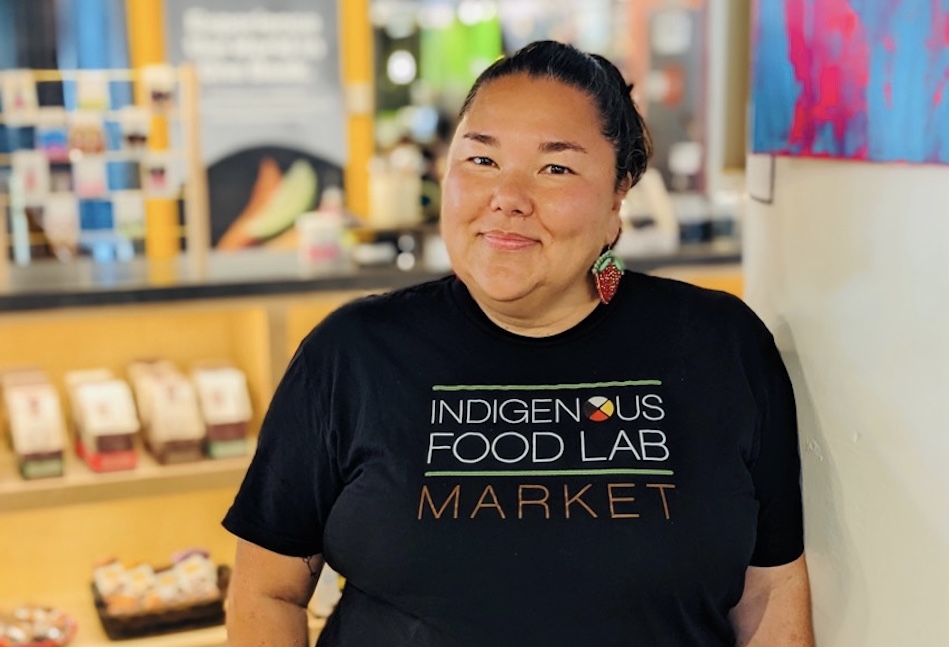
- Details
- By Chez Oxendine
- Food | Agriculture
Food is medicine, says ethnobotanist and food sovereignty activist Linda Black Elk. Unfortunately, a lot of Native communities have been denied or warned off of their own medicine, she adds.
Between misidentified plants, unfounded rumors of toxicity, racist food names, and a push towards processed foods, tribes’ relationship with food has been damaged, Black Elk told Tribal Business News. She describes ethnobotany as a study of that relationship — and as a way to repair it.
“The right food is medicine for Indigenous bodies,” Black Elk said, reeling off the health benefits of falsely criticized natural foods such as chokecherries, milkweed and buffalo berries. Reclaiming those foods is one way to support food sovereignty.
As a longtime food sovereignty coordinator at United Tribes Technical College in Bismarck, N.D., Black Elk has been widely published on the topic. Now, the Minneapolis-based nonprofit North American Traditional Indigenous Food Systems (NATIFS), led by Chef Sean Sherman, has announced Black Elk as its new educational programming and community engagement leader.
First up: getting the organization’s Indigenous Food Lab — a combination classroom, studio kitchen, and training center -— up and running. Black Elk spoke with Tribal Business News about NATIFS, ethnobotany and repairing Indigenous communities' relationship with their food. This interview has been condensed and edited for clarity and length.
What kind of work are you looking forward to doing with NATIFS?
A lot of the work I'm going to be doing is specifically going to be organizing and engaging. We'll be doing workshops and classes for the whole community on food sovereignty. It could be as simple as how do you cook wild rice without it turning to mush, or making meal kits for young kids in school who maybe want the ability to make healthier choices.
How do you cook wild rice without turning it into mush?
The key is to not overcook it. Really, it happens because you think you should cook it the way you cook white rice, and if you cook it that same way, it's not going to work out as well.
We’ve described food sovereignty before as an ability to maintain one’s own food systems. What does it mean to you?
Well, it’s more than having just enough food, because that’s food security, which is just calories. A bag of cheetos or a soda counts as food security. That's very different from Indigenous food sovereignty, which is the ability to make decisions about your food system, but also have the right to access to food that is going to nourish you beyond the physical. It's food that you have a connection with — food that feeds you emotionally, mentally, and spiritually.
How does that relate to ethnobotany?
For generations, colonial systems have campaigned to label Indigenous foods and medicines as “unsafe” or “ineffective.” I've seen important Indigenous foods mistakenly described as “toxic” — and this (type of) misinformation has led to a real fear of the natural world. I believe this fear campaign is completely intentional, because colonial systems don't make money off of food and medicine that we grow, gather, prepare, and preserve ourselves.
Can you give an example of an Indigenous food that’s been impacted by negative perception?
The first thing that comes to mind is milkweed. There are a few edible milkweed species on Turtle Island, but there's been this long standing rumor that milkweed is toxic, or that you have to boil it in five changes of water to make it edible. Otherwise, (people claim) it's incredibly bitter.
But that isn’t true?
Neither of those are true. Milkweed is an important food, and it's not bitter. I've literally never eaten bitter milkweed. I've talked to a lot of other gatherers and foragers, and we've come up with the theory that the rumor of bitter or toxic milkweed came from an early book on foraging.
In what other ways have Native foods been impacted?
Think about hog peanuts. Those are called earth beans or mouse beans by Natives, because mice will collect these beans in forests into little caches. They’re delicious, but they were called “hog peanuts” because colonialist settlers thought they were only good for “hogs and Indians.”
A lot of plants have racist names like that. But they were such vitally important food sources for people all throughout Turtle Island. I really encourage people to take a look at their cultural foods, their historically eaten foods.
So how do you start battling that perception of those foods?
We no longer use those words like hog peanut or rat potato. I think that that's a start. I think we also start talking about how we can use these foods, and talk about what’s toxic or what isn’t.
Like chokecherries? Those were seen as toxic for a long time.
To an extent that's true (because) choke cherries have cyanide in their pits. But because Indigenous people are brilliant and because of our knowledge base (of) Indigenous science, we know how to process chokecherries and make them edible. They taste really good. When you process them or cook them, they have a really deep cherry flavor and the pits give them an almond flavor. We crush and dry choke cherries into patties and those patties taste like cherries and almonds, almost like an almond bark.
So reclamation of our foods has already begun. What kind of impact is that having in Native communities?
They're learning how to identify plants again, but also (understand) the land, and the soil. They're starting to understand: "I notice these buffalo berries I'm looking for like to grow closer around ponds and lakes."
Once you get out there and start looking for these foods, you start noticing things (about) the relationship with the earth, with the soil, with the air. That's important to food sovereignty.
Now that you’re at NATIFS, what kind of work will you be doing toward this goal?
A lot of the work I'm going to be doing is specifically organizing and engaging, reaching out to tribes and nonprofits and other organizations to partner with us and work with us. We'll be doing workshops and classes for the whole community on food sovereignty.
My first project is really getting our studio kitchen together so we can offer classes to reteach community members about their traditional foods. It's also a space where elders and other community members can come in and teach.
So my first priority is to get that studio kitchen together at the Indigenous food lab so community members can teach and learn.
